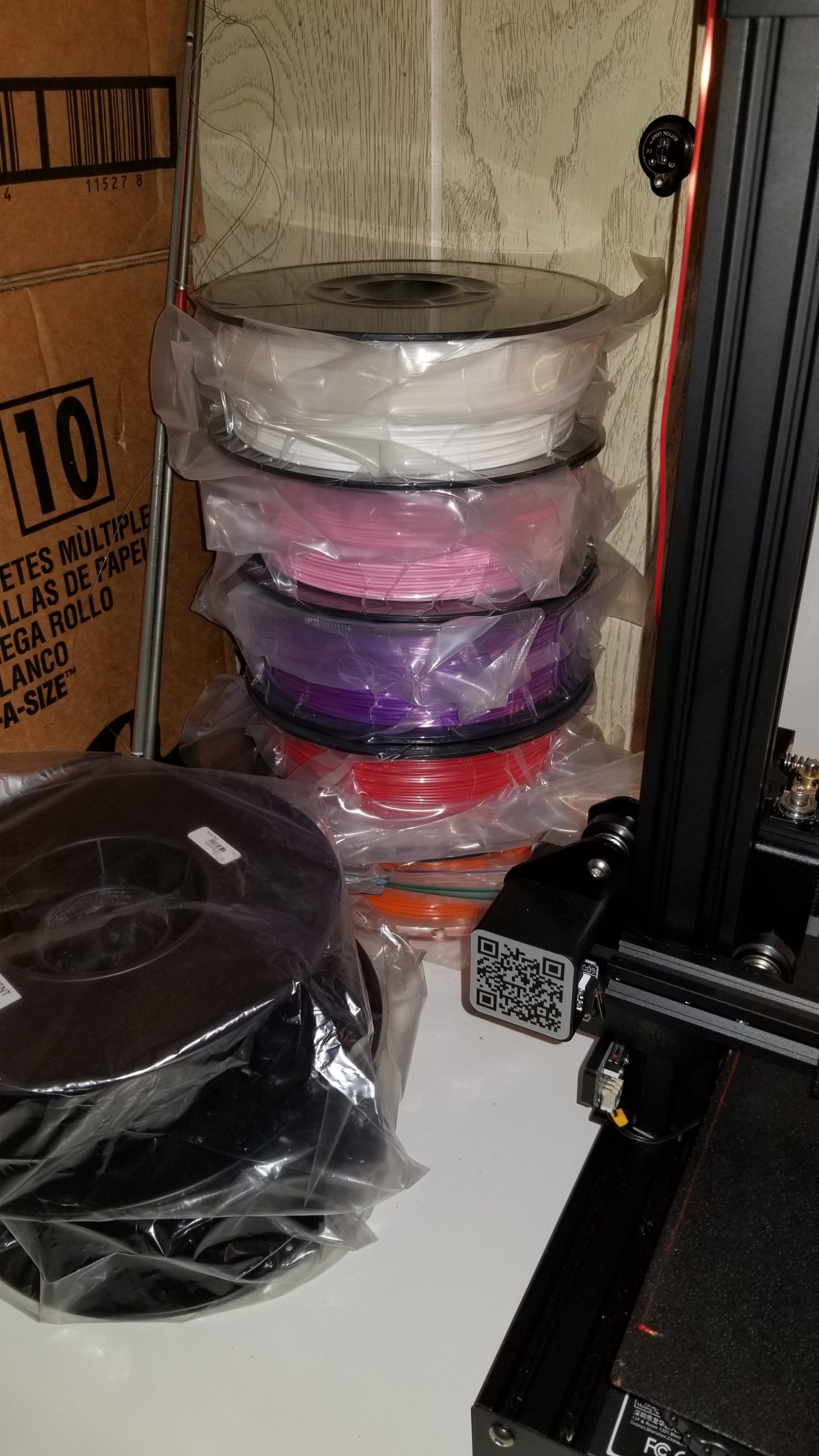I had a decent-sized print not that long ago that I “thought” I had enough filament for. I set it up on the printer, checked on it every few minutes for about an hour, everything seemed fine, so I went to bed.
Well, everything wasn’t fine because when I woke up that morning I saw that I didn’t have enough filament and my printer was ghost printing. Ghost printing is what I call a printer printing nothing.
This really isn’t that big of a deal, but it was the first time I had seen this happen, so it sparked my curiosity. I never thought about running out of filament during a print.
Now, you may wonder what to do if your printer runs out of filament during the printing job. Or, what exactly happens when your printer runs out of filament. Most 3D printers come with the option of pausing the print, while your print is paused you could just change the filament then.
So, if your 3D printer’s filament sensor is working perfectly fine, it will be paused. Then, you can proceed to change the filament. Some of them also have the option of unloading the old filament automatically.
What Do You Do When You Run Out of Filament During a Print?
In an ideal scenario, as mentioned above, your 3D printer has a filament sensor. Whenever it runs out of filament, it will pause and you can change the filament.
In most cases, it will alert you as well. Thus, you can proceed with changing the filament and unloading the remains of the previous filament.
Worst case scenario, your printer does not have a sensor, or even if it has, it does not work properly. This is where it can get tricky; because if you’re not keeping an eye on your 3D printer then the filament will run off and your print will be ruined.
Best case scenario(if you don’t have a sensor or it doesn’t work), you are around the 3D printer and you can change the filament by pausing the machine at the right time.
Most of the printers give you the option of pausing the 3D print job, loading the filament, and continuing the job. In another case, if you are aware of how to do editing of G-Code, you can utilize that to stop at a specific place as well.
Doing this requires a lot of skill and isn’t the best option in my opinion. You could mess up the code of your 3D printer all together and create a bigger problem.
It helps to keep track of how much filament you use during each print by subtracting that amount every time you print. Keep this information in a journal or in a spreadsheet on your computer.
The 3D printer runs out of Filament in your Absence.
Now, let’s assume that you are not anywhere near the 3D printer, and it runs out of filament. Hence, you did not have the option to intervene. In this case, there is a good chance that you might wonder what will happen.
If your printer had a filament sensor, it would pause the printing job, and then you can change the filament whenever you reach near the printer. But in some cases, your printer may lack a sensor, your sensor might not work properly, or something else may happen.
Now, the printer will continue to run without filament in it. Meaning your printing job will not be completed, and you will not achieve your desired results. Your 3D printer’s nozzle will continue completing the printing job but without extruding filaments. To handle such cases, you can use one of the techniques to avoid any problems in your printing job. These techniques are:
Measuring your Filament
One of the best ways to avoid this problem is to know when your printer will run out of filament. You have to measure your filament before loading it into the 3D printer. As stated earlier in the article, whenever you print something, take note of how much filament is being used.
Cura will tell you this along with how long it will take for your print to finish. Your filament spool will tell you how much is there on one side of it. Put this information in a notebook to keep track of how much filament you have.
Join the Filaments
Another way of saving your printing job is by joining the filament together. There are a few ways of doing this but after a bit of research on youtube and looking up reviews of products on Amazon.com, I decided to stay away from this myself.
I have no problem manually loading new filament into my printer. The products out right now just don’t seem quite there yet. Maybe we are close to a product that can safely and properly fuse filament together. But we don’t seem to be there yet.
Installing a Separate Sensor
If your printer does not come with a sensor that notifies you when filament ends, you can install a separate sensor. However, you must be careful that the separate sensor must be compatible with your printer.
Buy a sensor that you can use with the board of your 3D printer. This sensor will convey the signal to your printer whenever it runs out of filament. The 3D printer will pause until it is reloaded with a new filament.
Some Problems That May Occur
Installing a sensor may be a good idea, but still, there might be some problems. For example, if your sensor gives false signals, or it does not notify the printer when it runs out of filaments. If your sensor is working properly but this still occurs, some issues that you might want to look into are:
- Make sure that the surrounding filament and the loading place where you want to load the filament are clean.
- Extreme light conditions near the printer might be a cause of a false signal from the sensor.
- The filament is not inserted correctly.
- Some filaments may create an issue for the sensor. For example, colors like ivory, white, neon, or lime green, may cast more light on the sensor. This may result in a false alarm.
In case you are getting false alarms more than often, and the reason is light conditions, exotic filaments, or something similar, you can consider turning off the sensor. Also, you can use the sensor only when needed, like when you are away from the printer, or you fear that the printer may run out of filament.
Can Filament Be Fused Together?
Filament can be fused together but it is not an easy task. As I said before, after doing some research on youtube on the subject and reading reviews of some products on Amazon.com, I just don’t feel like we are there yet with this. The products just aren’t there yet.
If you do decide to go through with slicing your filament together just remember to use caution and follow the instructions of whatever process you choose to use very carefully. I haven’t found any youtube videos I feel are good enough to link on my website so unfortunately if you choose to do this you will have to do your own research.
But do know that it can be done, personally tho, I’d rather just let my filament run-out than add new filament. But that’s just me.
Whatever way you choose to fuse two filaments together, you must be aware of the following things:
- Never try to fuse filaments with direct flame. It is not only dangerous but gives you less control over the melting point.
- Do not try to fuse two different materials or two different brands together. There are chances of inconsistencies in print; it may jam the nozzle of your printer or may clog the motor.
- Cut each end of the filament for a more accurate and stronger bond.
What Do I Do If I Run Out of Resin During a Print?
If you run out of Resin, you can simply refill the VAT of the printer. For that, all you have to do is pause the printer, refill the resin, and resume the printing job. However, there are some other reasons this might cause some problems with your print. Here are some tips to avoid any failures in print:
- Clean the VAT of any cured resin so that there is only uncured resin in the VAT.
- You may also have to clean the 3D printer’s LCD screen. You may experience some failures in achieving a good 3D print job if you are not properly cleaning your screen or VAT.
- Check your FEP film and replace it if required.
- You must also set the correct exposure time depending on the type of your resin.
But it’s more simple than running out of filament on an FDM printer.
3D printing can be a tricky job but, if done in the right manner, can provide tremendous results. Only by following the proper procedure, cleaning thoroughly, and following the instructions can you achieve some fun results. You may also consider dividing the printing job into small batches and using super glue as an adhesive to join them later.

